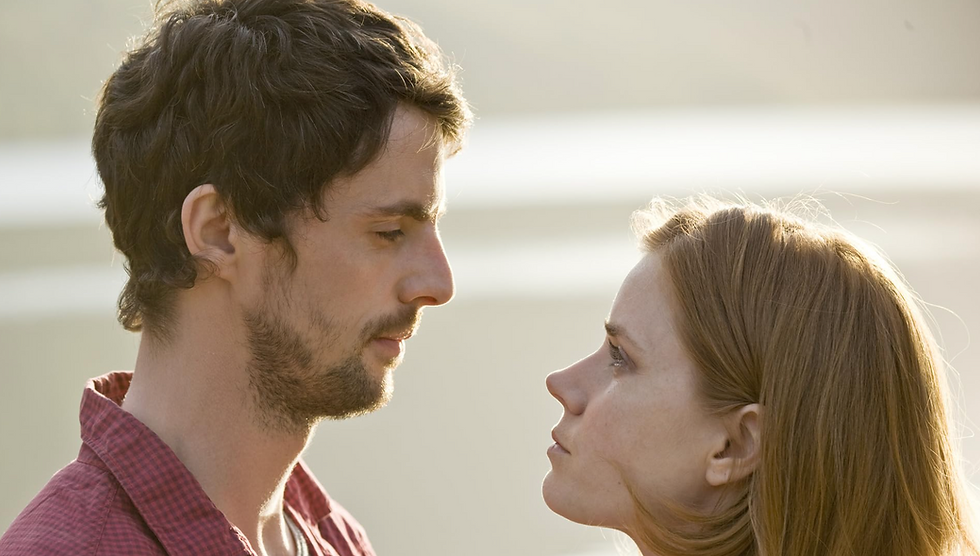- Julie Barris | Crisis Counselor | Therapist-in-Training

- Jul 27
What a romantic comedy reveals about emotional avoidance, perfectionism, and the quiet courage it takes to truly feel.

In the 2010 film Leap Year, Anna Brady (played by Amy Adams) is a woman with a clear path and a carefully designed life. She’s polished, organized, and driven — the kind of person who thrives on color-coded calendars and 5-year plans. When her long-time boyfriend still hasn’t proposed, Anna decides to take matters into her own hands. Following an old Irish tradition, she plans to propose to him on February 29th, leap day, during a business trip to Ireland.
It’s the perfect plan: romantic, symbolic, and, above all, strategic.
But as life (and every good rom-com) would have it, the trip goes sideways. Flights are cancelled, travel is rerouted, and she’s forced to enlist the help of Declan, a gruff yet emotionally intuitive Irish innkeeper, to drive her across the country.
What starts as a comedic series of mishaps quickly becomes a deeper journey — one that strips away Anna’s carefully crafted control and reveals just how emotionally detached she’s become.
What Lies Beneath the Plot: Control as a Coping Mechanism
On its surface, Leap Year is lighthearted and picturesque, but the psychology behind Anna’s behavior is layered. What she calls "taking charge" is, in many ways, a defense mechanism. Her meticulous planning and constant forward motion aren’t signs of confidence — they’re signs of fear.
This is where the film offers something unexpectedly insightful: Anna isn’t just trying to move her relationship forward — she’s trying to outrun emotional vulnerability.
In mental health terms, this is what we often call over-functioning. It’s a common dynamic, particularly among high-achieving adults, where someone manages, fixes, and plans not because they’re emotionally grounded — but because they’re emotionally guarded. The very behaviors that make someone seem “put together” are often the same ones keeping them disconnected from themselves and others.
Anna’s decision to propose — while framed as empowering — is actually a form of emotional self-protection. By scripting the relationship and forcing a next step, she avoids the uncertainty of asking deeper questions like: Am I truly happy? Do I feel emotionally safe with this person? What do I want outside of this plan?
Emotional Avoidance: When Busy Means Numb
Anna’s coping style is rooted in what therapists call emotional avoidance — using action, logic, or external control to escape from uncomfortable feelings. This shows up when someone keeps busy instead of feeling grief, intellectualizes instead of expressing sadness, or fixes everyone else’s problems instead of facing their own pain.
It’s a survival strategy, often learned early in life, especially by those who grew up in emotionally unpredictable or high-pressure environments. Over time, staying “busy” becomes synonymous with staying safe.
But the problem is this: you can’t selectively numb. When we push away fear, grief, or uncertainty, we often push away joy, intimacy, and connection, too. That’s exactly what Anna experiences. Her life looks beautiful on the outside, but she’s emotionally flatlined — disconnected from her own wants, instincts, and emotional truth.
Leap Year cleverly uses physical detours and delays to mirror Anna’s internal journey: her plans fall apart so that she can fall inward.
Declan: The Mirror She Didn’t Know She Needed
Enter Declan — the emotionally scruffy Irish innkeeper who seems to live by intuition, mess, and quiet honesty. At first glance, he’s Anna’s complete opposite. But as they’re forced to spend time together navigating the Irish countryside, something deeper unfolds.
Declan doesn’t just help Anna get from point A to point B. He challenges her emotional blueprint. He points out her discomfort with uncertainty, her performative confidence, and her inability to sit with discomfort — not in a cruel way, but with a kind of grounded insight that only someone who’s done their own healing can offer.
He doesn’t ask her to change. He simply invites her to be more herself.
And that’s the turning point: when Anna starts letting go of how things “should” look and begins noticing how she actually feels — uncomfortable, unsure, but also alive and curious. Through Declan, she begins to experience what it feels like to be emotionally present, even in messiness. It’s in this space — not the perfect proposal — where intimacy actually grows.
From Survival Mode to Emotional Freedom
By the end of Leap Year, Anna’s biggest leap isn’t the journey across Ireland or the question she originally came to ask. It’s the shift from performing her life to living it honestly.
This is what healing often looks like: not dramatic transformations or Hollywood moments, but subtle changes in how we relate to ourselves. It’s the courage to say, “I don’t know,” to slow down long enough to feel your feelings, and to admit that what you’ve been doing — even if it looks good on paper — isn’t emotionally sustainable.
For high-functioning adults, this can be one of the hardest truths to accept: that outward success doesn’t mean inner peace. That doing everything “right” doesn’t mean you’re doing what’s real.
Leap Year ends not with a perfectly planned future, but with a moment of emotional clarity — a choice to be present, vulnerable, and connected.
The Takeaway: Control May Feel Safe, But Connection Heals
Romantic comedies don’t always aim to offer therapeutic insight, but Leap Year does something quietly profound. It shows that sometimes we hide behind plans and perfection not because we’re confident — but because we’re afraid of being seen.
And sometimes, healing begins when we allow ourselves to be seen anyway.
Eye-Opening Final Question:
What parts of your life are you micromanaging to avoid what you’re really feeling — and what might change if you let yourself feel instead of just function?
💬 Ready to start your own healing journey?
Book a session with one of our compassionate therapists at Moody Melon Counseling. We’re here when you’re ready. 🍉





